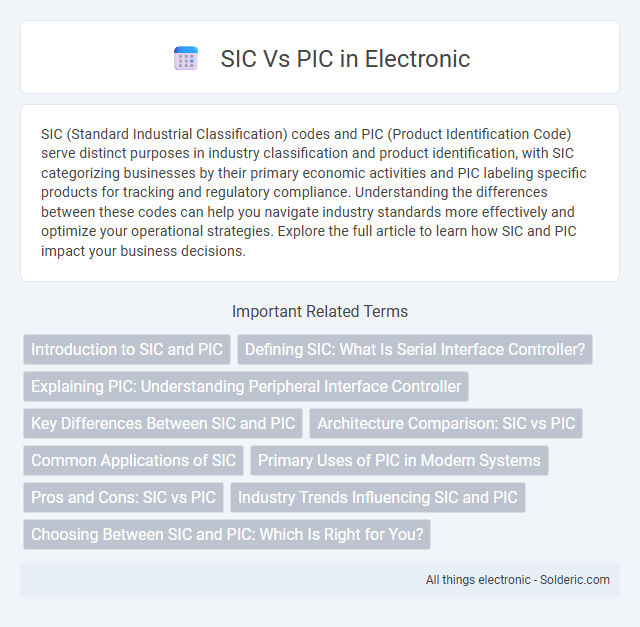SIC (Standard Industrial Classification) codes and PIC (Product Identification Code) serve distinct purposes in industry classification and product identification, with SIC categorizing businesses by their primary economic activities and PIC labeling specific products for tracking and regulatory compliance. Understanding the differences between these codes can help you navigate industry standards more effectively and optimize your operational strategies. Explore the full article to learn how SIC and PIC impact your business decisions.
Comparison Table
| Feature | SIC (Standard Industrial Classification) | PIC (Product Identification Code) |
|---|---|---|
| Purpose | Classifies industries by business activities | Identifies products for tracking and inventory |
| Scope | Industry-level classification | Product-level classification |
| Code Format | 4-digit numeric codes | Alphanumeric codes of variable length |
| Use Cases | Economic analysis, regulatory reporting, market research | Inventory management, sales tracking, product categorization |
| Authority | Developed and maintained by government agencies (e.g., US SEC) | Defined by manufacturers or industry standards |
| Examples | 0111 - Wheat Farming | SKU12345 - Blue T-shirt, Size M |
Introduction to SIC and PIC
Silicon Controlled Rectifiers (SIC) are four-layer semiconductor devices primarily used in high-power applications for controlling large electrical currents. Programmable Interface Controllers (PIC) are versatile microcontrollers developed by Microchip Technology, widely utilized in embedded system design due to their low power consumption and extensive peripheral support. Understanding the basic structure and operation of SIC and PIC is essential for selecting the appropriate component in power electronics and microcontroller projects.
Defining SIC: What Is Serial Interface Controller?
A Serial Interface Controller (SIC) is a hardware component that manages serial communication protocols by controlling data transfer between devices through serial ports. It optimizes the timing, data framing, and error checking processes to ensure efficient and reliable exchange of information over serial interfaces like UART, SPI, or I2C. SIC differs from a Peripheral Interface Controller (PIC), which is generally a microcontroller used for a broader range of embedded system applications beyond just serial communication.
Explaining PIC: Understanding Peripheral Interface Controller
Peripheral Interface Controller (PIC) is a family of microcontrollers developed by Microchip Technology, known for its versatility in embedded systems and real-time applications. PIC microcontrollers integrate memory, peripherals, and processing units on a single chip, enabling efficient control of devices such as sensors, motors, and communication modules. You can optimize your design by selecting PIC microcontrollers tailored to specific tasks, benefiting from their low power consumption and ease of programming.
Key Differences Between SIC and PIC
SIC (Social Insurance Contribution) and PIC (Personal Income Contribution) differ primarily in their application and purpose within payroll systems. SIC is a mandatory employer and employee contribution towards social security benefits, covering healthcare, pensions, and unemployment, whereas PIC refers to the tax withheld on your personal income from employment or business earnings. Understanding the distinction helps ensure compliance with tax regulations and accurate payroll processing.
Architecture Comparison: SIC vs PIC
SIC (Single Instruction Counter) architecture relies on a single program counter to fetch and execute instructions sequentially, offering simplicity and ease of implementation. In contrast, PIC (Programmable Interrupt Controller) architecture integrates multiple interrupt handling capabilities, providing more complex control flow and improved response to asynchronous events. Your choice between SIC and PIC architectures impacts system performance and efficiency based on the required instruction processing and interrupt handling complexity.
Common Applications of SIC
Silicon Carbide (SiC) is widely used in high-power electronics, such as electric vehicle inverters, renewable energy systems, and power supplies due to its superior thermal conductivity and high breakdown voltage. SiC devices enhance efficiency and reliability in industrial motor drives, aerospace, and defense applications, where high-temperature and high-frequency performance are critical. Your choice of SiC technology can significantly improve power density and reduce energy losses compared to traditional silicon-based components.
Primary Uses of PIC in Modern Systems
PICs (Programmable Interrupt Controllers) are primarily used in modern computer systems to manage hardware interrupts efficiently, enabling the CPU to handle multiple interrupt requests by prioritizing and directing them appropriately. They play a crucial role in real-time operating systems and embedded devices where timely and organized interrupt processing is essential for performance and stability. PICs enhance system responsiveness by offloading interrupt management from the CPU, which allows for smoother multitasking and improved overall system operation.
Pros and Cons: SIC vs PIC
SIC (Silicon Carbide) offers superior thermal conductivity and higher breakdown voltage compared to PIC (Plastic Integrated Circuit), making it ideal for high-power and high-frequency applications. However, SIC devices tend to be more expensive and harder to manufacture, limiting their use in cost-sensitive, low-power circuits where PICs excel due to their low cost, ease of mass production, and adequate performance. The choice between SIC and PIC hinges on balancing performance demands against budget constraints and application-specific requirements.
Industry Trends Influencing SIC and PIC
Industry trends such as the growing demand for miniaturized electronics and the expansion of wearable technology are driving advancements in both SIC (Silicon Carbide) and PIC (Photonic Integrated Circuits) technologies. SIC's superior thermal and electrical properties position it as a key material for high-power, high-frequency applications in electric vehicles and renewable energy systems. Your understanding of PIC benefits from its increasing adoption in data centers and telecommunications, where integrated photonics enhances speed and energy efficiency.
Choosing Between SIC and PIC: Which Is Right for You?
Choosing between Serial Interface Controller (SIC) and Programmable Interface Controller (PIC) depends on your project's communication needs and processing requirements. SIC is ideal for applications requiring standardized, high-speed serial data transmission, offering robust protocol support, while PIC microcontrollers excel in versatile, low-power embedded systems with customizable peripherals. Evaluating factors like data throughput, control complexity, and power consumption ensures selecting the optimal controller for efficient and scalable system design.
SIC vs PIC Infographic

 solderic.com
solderic.com